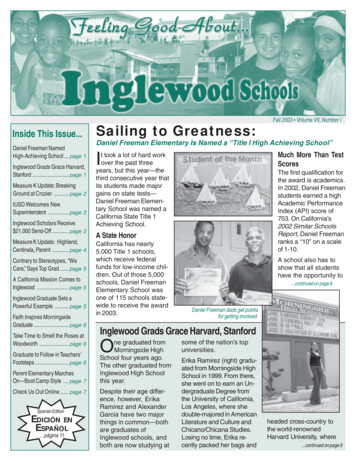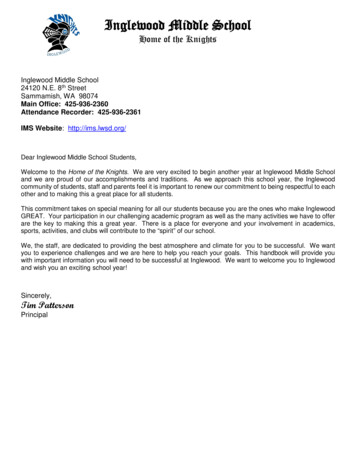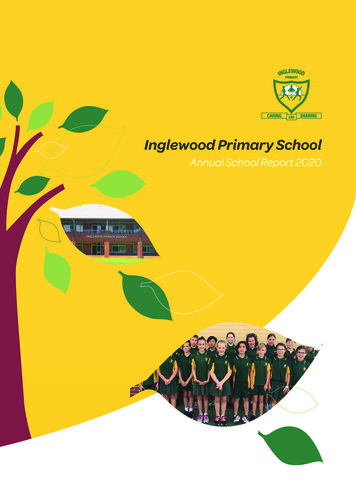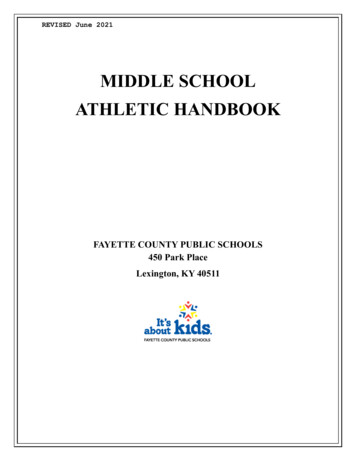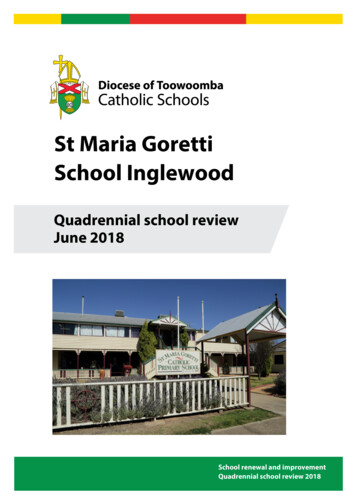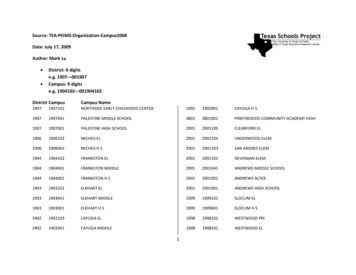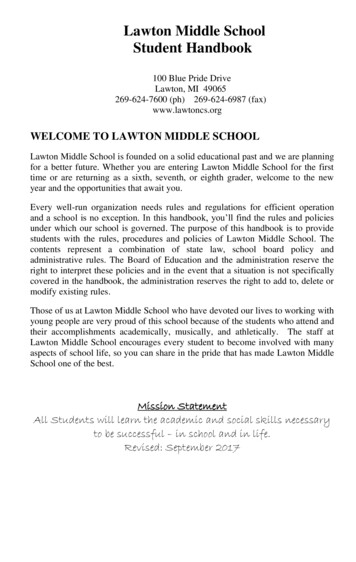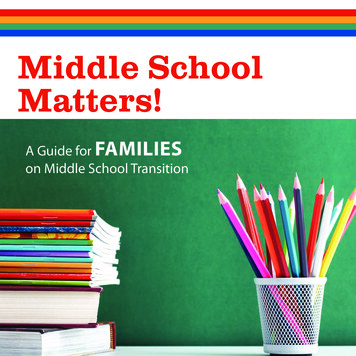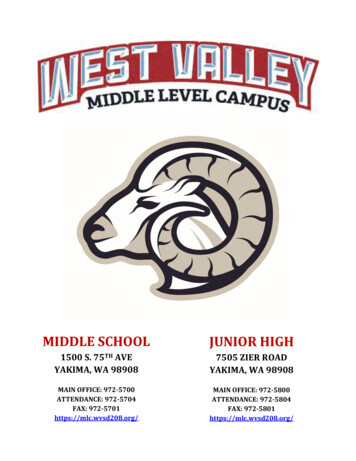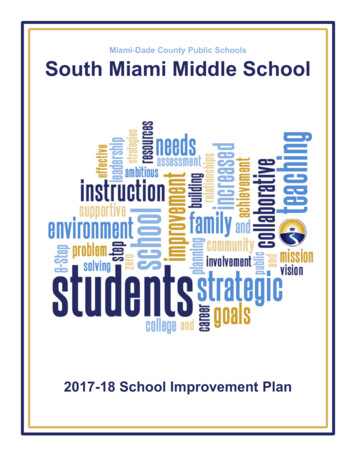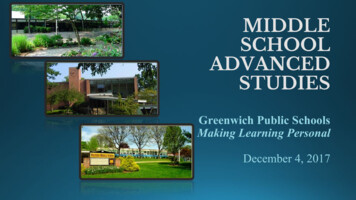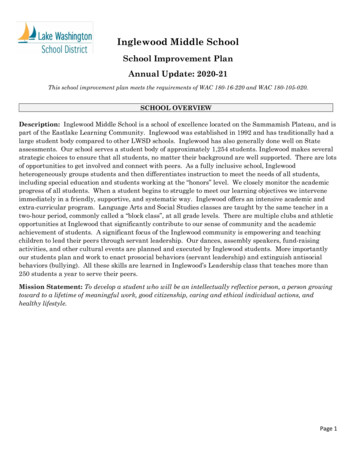
Transcription
Inglewood Middle SchoolSchool Improvement PlanAnnual Update: 2020-21This school improvement plan meets the requirements of WAC 180-16-220 and WAC 180-105-020.SCHOOL OVERVIEWDescription: Inglewood Middle School is a school of excellence located on the Sammamish Plateau, and ispart of the Eastlake Learning Community. Inglewood was established in 1992 and has traditionally had alarge student body compared to other LWSD schools. Inglewood has also generally done well on Stateassessments. Our school serves a student body of approximately 1,254 students. Inglewood makes severalstrategic choices to ensure that all students, no matter their background are well supported. There are lotsof opportunities to get involved and connect with peers. As a fully inclusive school, Inglewoodheterogeneously groups students and then differentiates instruction to meet the needs of all students,including special education and students working at the “honors” level. We closely monitor the academicprogress of all students. When a student begins to struggle to meet our learning objectives we interveneimmediately in a friendly, supportive, and systematic way. Inglewood offers an intensive academic andextra-curricular program. Language Arts and Social Studies classes are taught by the same teacher in atwo-hour period, commonly called a “block class”, at all grade levels. There are multiple clubs and athleticopportunities at Inglewood that significantly contribute to our sense of community and the academicachievement of students. A significant focus of the Inglewood community is empowering and teachingchildren to lead their peers through servant leadership. Our dances, assembly speakers, fund-raisingactivities, and other cultural events are planned and executed by Inglewood students. More importantlyour students plan and work to enact prosocial behaviors (servant leadership) and extinguish antisocialbehaviors (bullying). All these skills are learned in Inglewood’s Leadership class that teaches more than250 students a year to serve their peers.Mission Statement: To develop a student who will be an intellectually reflective person, a person growingtoward to a lifetime of meaningful work, good citizenship, caring and ethical individual actions, andhealthy lifestyle.Page 1
Demographics:1Student Enrollment (count)Racial Diversity (%) American Indian/Alaskan NativeAsianBlack/African AmericanHispanic/Latino of any race(s)Native Hawaiian/Other Pacific IslanderTwo or more racesWhiteStudents Eligible for Free/Reduced Price Meals (%)Students Receiving Special Education Services (%)English Language Learners (%)Students with a First Language Other Than English ment and racial diversity based on annual October 1 headcount. Students included in program count (FRL, SpEd, EL) if enrolled on October 1and receiving services at any time during that school year.Page 2
ACADEMIC PERFORMANCE DATA:LITERACYELA: By Grade Level, Smarter Balanced AssessmentGrade6th Grade7th Grade8th GradePercent at or above standard2016-17 2017-18 2018-19 2019-20858388n/a909088n/a858684n/aELA: By Group/Program, Smarter Balanced Hispanic/LatinoTwo or moreracesWhiteEnglish LearnerLow IncomeSpecialEducationPercent at or above standard2016-17 2017-18 2018-19 08350523884645341n/an/an/an/aACADEMIC PERFORMANCE DATA:MATHMATH: By Grade Level, Smarter Balanced AssessmentGrade6th Grade7th Grade8th Grade2016-17848382Percent at or above MATH: By Group/Program, Smarter Balanced Hispanic/LatinoTwo or moreracesWhiteEnglish LearnerLow IncomeSpecialEducation2016-179467Percent at or above DEMIC PERFORMANCE DATA:SCIENCESCIENCE: By Grade Level, WCAS3Grade8th GradePercent at or above standard2016-17 2017-18 2018-19 2019-20n/a8285n/a Cohort Trackn/a not availableSCIENCE: By Group/Program, c/LatinoTwo or moreracesWhiteEnglish LearnerLow IncomeSpecialEducationPercent at or above standard2016-17 2017-18 2018-19 an/an/a78503284405645n/an/an/an/a2Grades 6-8 combined. Student/Program groups with less than 10 students marked as “-“ and data not displayed due to privacy reasons. “AmericanIndian/Alaskan Native” and “Native Hawaiian/Other Pacific Islander” not included in report due to fewer than 10 students in all categories.3WCAS Washington Comprehensive Assessment of Science. Given only to 8th grade at the middle school level. Assessment first given in 2017-18.Page 3
ATTENDANCE DATAATTENDANCE: By Group/Program4ATTENDANCE: By GradeGradePercent avoiding chronic absenteeism2016-172017-18 2018-19 2019-206th Grade7th Grade949294949493n/an/a8th canHispanic/LatinoTwo or more racesWhiteEnglish LearnerLow IncomeSpecial EducationPercent avoiding chronic absenteeism2016- 2017-18 2018-19 79949291978487n/an/an/an/an/an/aWASHINGTON SCHOOL IMPROVEMENT FRAMEWORK (WSIF) DATAMOST RECENT WSIF 3-YEAR icanAmerican81White88Two 1Studentswithdisabilities44ELA Proficiency Rate(%)Math Proficiency Rate(%)ELA Median StudentGrowth Percentile6Math Median StudentGrowth PercentileEL Progress Rate ar AttendanceRate (%)949783929393958684 Cohort Trackn/a not available4Grades 6-8 combined. Student/Program groups with less than 10 students marked as “-“ and data not displayed due to privacy reasons.Washington School Improvement Framework measures compile data across three years (2017-2019) and include both the general educationassessment (Smarter Balanced assessments) and the alternative assessment for student with severe cognitive disabilities (WA-AIM). OSPIsuppression rules apply to some data marked as “-“ and not displayed due to privacy reasons.6Median Student Growth Percentile is calculated by ordering individual student growth percentiles from lowest to highest and identifying the middlescore. Washington State defines an SGP of 1-33 as low, 34-66 as typical, and 67-99 as high.5Page 4
CONTINUOUS IMPROVEMENT PRIORITIESOur target is that all students and student groups are improving, with all gaps closing, each year. Thefollowing priorities have been set to guide us in achieving this.Priority #1Priority AreaEnglish Language Arts/LiteracyFocus AreaPercent of “Special Education” students achieving standardFocus Grade Level(s)6, 7, 8Desired OutcomeThe percent of “Special Education” students achieving standard willincrease from 41% to 44% as measured by the 2021 Summative SBA.Alignment with DistrictStrategic InitiativesCulturally Responsive TeachingData and RationaleSupporting Focus AreaSBA data indicates that the number of “Special Education” studentsmeeting standard on the SBA has dramatically declined in the past 3 schoolyears. This is a definite pattern which is more pronounced undesiredpatterns found with other groups.Strategy to AddressPriorityActionDevelop a methodology to trackthis student group’s performanceon grade-level assessments.SIOP Training with a focus on theuse of these tools to serve EnglishLanguage Learners and underresourced studentsUsing many of the tools that wehave learned in our equity efforts,we will audit Inglewood practicesto remove barriers to studentsuccess.Measure of Fidelity ofImplementationAn excel tool will be developed anda Standard Operation Procedurecreated to allow grade level teacherteams to track how this group ofstudents is doing compared to the“All Inglewood” peer group. Thiswas developed in December 1, 2019Training dates will be posted, andteacher evaluation of the trainingswill be solicited and kept asdocumentation.An initial audit began in the Fall2019 and was completed inFebruary 2020. Ongoingassessment of equity efforts willcontinue throughout the SIP cycle(concluding June 1, 2021). Thenotes and results of this survey willbe posted for staff review.Timeline for FocusFall, 2019 - Spring, 2021Method(s) to MonitorProgressEach Month, progress on this goal will be discussed at Inglewood’s BuildingLeadership Team, and at Inglewood’s Equity team. The purpose of thepresentation will be two-fold. The first purpose will be a progress check,enabling our school to continuously return to the SIP and ensureimplementation with fidelity. The second purpose will be to solicit stafffeedback and input, allowing us to better focus over time.Page 5
Priority #2Priority AreaMathematicsFocus AreaPercent of “Special Education” students achieving standardFocus Grade Level(s)6, 7, 8Desired OutcomeThe percent of “Special Education” students achieving standard willincrease from 37% to 42% as measured by the 2021 Summative SBA.Alignment with DistrictStrategic InitiativesMulti-Tiered Systems of Support - Academics (MTSS-A)Data and RationaleSupporting Focus AreaSBA data indicates that the number of “Special Education” studentsmeeting standard on the SBA has dramatically declined in the past 3 schoolyears. This is a definite pattern which is more pronounced undesiredpatterns found with other groups.Strategy to AddressPriorityActionDevelop a methodology to trackthis student group’s performanceon grade-level assessments.SIOP Training with a focus on theuse of these tools to serve EnglishLanguage Learners and underresourced studentsUsing many of the tools that wehave learned in our equity efforts,we will audit Inglewood practicesto remove barriers to studentsuccess.Measure of Fidelity ofImplementationAn excel tool will be developed anda Standard Operation Procedurecreated to allow grade level teacherteams to track how this group ofstudents is doing compared to the“All Inglewood” peer group. Thiswas developed in December 1, 2019Training dates will be posted, andteacher evaluation of the trainingswill be solicited and kept asdocumentation.An initial audit began in the Fall2019 and was completed inFebruary 2020. Ongoingassessment of equity efforts willcontinue throughout the SIP cycle(concluding June 1, 2021). Thenotes and results of this survey willbe posted for staff review.Timeline for FocusFall, 2019 - Spring, 2021Method(s) to MonitorProgressEach Month, progress on this goal will be discussed at Inglewood’s BuildingLeadership Team, and at Inglewood’s Equity team. The purpose of thepresentation will be two-fold. The first purpose will be a progress check,enabling our school to continuously return to the SIP and ensureimplementation with fidelity. The second purpose will be to solicit stafffeedback and input, allowing us to better focus over time.Page 6
Priority #3Priority AreaSocial and EmotionalFocus AreaImplementation of Character Strong through-out InglewoodFocus Grade Level(s)6, 7, 8Desired OutcomeTeachers are well trained and deliver high quality character strong lessonsto all Inglewood studentsAlignment with DistrictStrategic InitiativesMulti-Tiered Systems of Support - Academics (MTSS-A)Data and RationaleSupporting Focus AreaPrior to the 2018-2019 school year there had been a 5-year increase inexclusionary discipline at Inglewood culminating in 36 exclusionary events.Through the implementation of portions of Character Strong, through ourLeadership class, we reduced exclusionary discipline to 26 exclusionaryevents. We believe that school-wide implementation will further reduce ourdiscipline.Strategy to AddressPriorityActionIn August of 2019 the entire facultyof Inglewood attended the LWSDtraining on Character Strong. Inaddition, new staff to Inglewood inthe 2020-21 school year weretrained in November 2020.In September of 2019 a U-KnightedCommittee with a focus onimplementing Character Stronglessons was formed.Each Month the U-KnightedCommittee will meet, review theCharacter Strong curriculum, andplan activities for UnknightedThe U-knighted Calendar, withlessons will be kept up to date anduseable by Inglewood StaffIn January and April, the staff willbe surveyed to understand theirlevel of comfort and theirprofessional development needsrelating to Character StrongMeasure of Fidelity ofImplementationThe faculty attended the trainingat Redmond High School.The U-Knighted Committee wasformed, and lessons started to beposted in September of 2019.A review of the PCC at Inglewoodcalendar, on SharePoint, willprovide documentation thatactivities are planned through-outthe school year.A review of the PCC at Inglewoodcalendar, on SharePoint, willprovide documentation thatactivities are planned through-outthe school year.The results of these surveys will beshared with the IMS U-KnightedCommittee, and the BCL team.Both groups will review the dataand make recommendations.Timeline for FocusFall, 2019 - Spring, 2021Method(s) to MonitorProgressThe primary method of progress monitoring will be regularly scheduledreview of the U-Knighted Committee’s work, both by the committee itselfand by the BCL team (Teacher Leaders).Page 7
Priority #4Priority AreaFocused Professional DevelopmentFocus AreaRegular, Timely professional development for Inglewood Faculty and StaffFocus Grade Level(s)6, 7, 8Desired OutcomeBoth the Inglewood Teaching Staff, and the Inglewood classified staffsuccessfully participate in timely professional development improving theirpersonal interactions and academic effectiveness.Alignment with DistrictStrategic InitiativesRecruitment and RetentionData and RationaleSupporting Focus AreaWhen reviewing the 2019 Nine Characteristics of Highly Effective Schoolssurvey the staff noted that 5% of teaching staff indicated that they “stronglydisagreed” that they received focused professional development over thecourse of the school year.Strategy to AddressPriorityActionMeet with the Inglewood TeacherLeadership Team to determinewhat professional development isneeded and review current plansCommunicate PD to take placeduring Professional LearningLEAP, Team Collaboration, andFaculty Meeting Time in theweekly Principal’s BulletinImplement the agreed upon PDand solicit teacher evaluation ofthe PDMeasure of Fidelity ofImplementationThis will be reflected in the BCL(leadership team name) notes. Atthe end of the year an audit of theBCL notes should reflect thisdiscussion taking place eachmonth.This will take place weekly andwill be easily audited in the“IMS LEAP Schedule” documentthat is attached to the Principal’sBulletinTeacher Evaluations of each LEAPWeek’s PD will be solicited usingand Microsoft form. The resultswill be both archived and presentedat Teacher Leadership meetingseach monthTimeline for FocusFall, 2019 - Spring, 2021Method(s) to MonitorProgressThe primary method of progress monitoring will be the inclusion ofProfessional Development input and evaluation in Inglewood’s teacherleadership meetings called “BCL meetings”. By making this a conversationthat takes place each month this priority will be continually refined andimproved upon.Page 8
TECHNOLOGY INTEGRATION PLANThe Washington Basic Education Act requires schools to “integrate technology literacy and fluency” intheir curriculum. The updated K-12 Educational Technology Learning Standards emphasize the waystechnology can be used to amplify and transform learning and teaching.The Technology Integration Facilitator Program (TIF) and Building Instructional Technology Plan (BIT)provide the structure and funding to support this requirement.The goals of the TIF program are to support teachers in effectively:1.2.3.4.Integrating the use of core instructional technologies within teaching and learning.Utilizing digital tools to enhance the learning process for all students in all classrooms.Understanding and applying the Educational Technology Learning Standards across content areas.Embedding digital citizenship and media literacy within instruction.Building administrators work with their Technology Integration Facilitator (TIF) to identify needs basedon the TIF program goals and develop the BIT Plan to meet those needs. Beginning and end of year surveydata informs the personalization of individual school plans.Based on Fall data, strategic implementations and OSPI requirements, the BIT Plan will focus on thefollowing: Digital Citizenship Integrating core instructional technologies Utilizing digital tools to enhance learning Applying Ed Tech Learning Standards Embedding digital citizenship & media literacy Teaching digital learning in both traditional and remote learning settingsSTATE ASSESSMENT PARTICIPATIONThe Every Student Succeeds Act (ESSA) requires that all schools meet at least a 95% participation rate forstate assessments for all students as well as each subgroup. Schools that fall below this threshold in anygroup must include goals and actions the school will take to ensure 95% of students participate. The latestparticipation rate that has been published by OSPI for the school was for state testing in spring 2019.During that year, the participation rate was not met.Strategies the school is using to meet participation requirements include: Common language on the importance of state testing is used by all schools in the district. Staff receive training on the administration of state assessments, including the use of supports andaccommodations to ensure all students have an equal opportunity to demonstrate learning. Make-up testing is provided for students that miss the school’s date. Test completion lists are monitored by both school testing coordinators and district personnel. The district is using the recommended refusal procedures and form developed by the WashingtonEducational Research Association.Page 9
COMMUNITY ENGAGEMENT PLANAs a district of doers, learners, and believers, our “why” drives us. We do this all-important work becausewe want all of our students to have equitable and quality experiences in the Lake Washington SchoolDistrict in order to ensure that they get to choose their futures instead of their circumstances choosingthem.Research has consistently shown that family and community engagement is key to increasing the academicsuccess and positive connections that students have at school, especially students from groups that aredemographically under-represented or those historically marginalized. Therefore, it is imperative that weconsistently plan and implement strategies to engage our families and school communities in authentic andculturally appropriate approaches.To ensure that families have the support that they need to assist their children, OSPI requires that schooldistricts have a family engagement policy in place that applies to all families.7 The specific strategy ourschool is using to involve and inform the community of the School Improvement Plan is as follows:Strategy to EngageStudents, Families,Parents andCommunityMembers in thedevelopment of theSIPStrategy to InformStudents, Families,Parents andCommunityMembers of theSIP7ActionSIP was presented, and inputsolicited at the Inglewood PTSAgeneral membership meetings.The SIP was presented, and inputsolicited at the InglewoodPrincipal’s Chat.The SIP was presented, and inputsolicited, at the Inglewood EquityTeam meetings.Student input regarding Priority#3 During KnightedActionThe SIP will be posted to theInglewood website.The SIP progress monitoring willbe part of the Principal Report atPTSA Board Meetings and GeneralMembership meetings.The SIP progress monitoring willbecome part of Inglewood’s EquityTeam meeting.Discussion of the SIP will become aregular part of the Principal’s ChatTimelineThis took place initially during themonth of October 2019 and anupdate occurred in November 2020.This took place initially during themonth of October 2019 and anupdate occurred in November 2020.This took place initially during themonth of October 2019 and anupdate occurred in November 2020.This took place during our UKnighted time and is on-going.TimelineImmediately upon approvalThis began in January of 2020 andwill take place monthlyThis began in January of 2020 andwill take place monthlyThis began in January of 2020 andwill take place monthlyLWSD’s policy is found at: ogram-4265Page 10
This school improvement plan meets the requirements of WAC 180-16-220 and WAC 180-105-020. SCHOOL OVERVIEW Description: Inglewood Middle School is a school of excellence located on the Sammamish Plateau, and is part of the Eastlake Learning Community. Inglewood was established in 1992 and has traditionally had a
